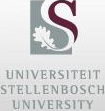212 (8) Introductory Biometry (2L, 1T / 1P)
Role of statistics in research; methods
Flexible assessment
P Mathematics (Bio) 124 or Mathematics 114
Module co-ordinator: Mr S van der Westhuizen
Lecturers: Mr S van der Westhuizen and Ms Samantha Joao
242 (8) Applications in Biometry (2L, 1T / 1P)
Treatment and experimental design; efficiency of estimation; analysis of variance; hypothesis tests for means and differences between means: F-test, t-test, Student’s LSD; confidence intervals; non-parametric tests; multiple linear regression. All data will be analysed using applicable software.
Flexible assessment
P Biometry 212
Module co-ordinator: Mr S van der Westhuizen
Lecturers: Mr S van der Westhuizen and Ms Samantha Joao
311 (8) Advanced regression and ANOVA (1L, 1P, 1T)
Matrix algebra; generalized linear models; power analysis; simple- and multiple linear regression; polynomial regression; logistical regression; diagnostic tests for influential observations; analysis of covariance; testing model assumptions.
Flexible assessment
P Biometry 242
Module Co-ordinator: Mr S van der Westhuizen
Lecturer: Mr S van der Westhuizen
711 (8) and 811 (8) Biometrical applications and data analysis in SAS
Data
processing and graphical procedures with SAS Enterprise Guide. Simple
descriptive statistics; t-tests for single populations, independent samples
t-tests and paired t-tests for two populations; analysis of variance:
completely random design, random-blocks design, Latin-square design,
cross-classification designs; repeated-measures analysis of variance; multiple
comparison procedures. Power analysis. Non-parametric tests: Mann-Whitney,
Wilcoxon, Kruskal-Wallis and Friedman; linear regression and correlation;
polynomial regression, multiple regression; selection of independent variables
with stepwise regression and all-subset regression; covariance analysis;
categorical data analyses (Chi-squared tests); logistic regression. This module
is presented in two blocks of five half days each in the first semester.
Flexible assessment.
P Biometry 212 and 242, 211. Students with different undergraduate Statistics modules must obtain at least 50% for an admission examination.
Module co-ordinator and lecturer: Ms Samantha Joao
721 (8) and 821 (8) Biometrical applications and data analysis in R
Data
processing and graphical procedures with R. Simple
descriptive statistics; t-tests for single populations, independent samples
t-tests and paired t-tests for two populations; analysis of variance:
completely random design, random-blocks design, Latin-square design,
cross-classification designs; repeated-measures analysis of variance; multiple
comparison procedures. Power analysis. Non-parametric tests: Mann-Whitney,
Wilcoxon, Kruskal-Wallis and Friedman; linear regression and correlation;
polynomial regression, multiple regression; selection of independent variables
with stepwise regression and all-subset regression; covariance analysis;
categorical data analyses (Chi-squared tests); logistic regression. This module
is presented in two blocks of five half days each in the first semester.
Flexible assessment.
P Biometry 212 and 242, 211. Students with different undergraduate Statistics modules must obtain at least 50% for an admission examination.
Module co-ordinator and lecturer: Mr S van der Westhuizen

